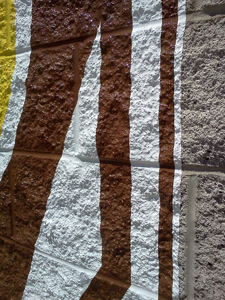Thanks to advances in vinyl film and adhesives, nearly any wall surface is a possible canvas for vinyl wraps. And it doesn’t matter if the wall is indoors or out, as PrintWorks Group proved on a recent job for Valparaiso University.
Course 101: Design
Founded in 2000 as a filmhouse for a printer, the company has been using its HP 5000 printer to branch out into outputting more large format jobs for customers—everything from design to branding to printing to wrapping. PrintWorks Group has worked frequently with Valparaiso University over the years on banners and other graphics.
Originally the school approached the company about a paint job. “They wanted us to make a stencil or a decal so the painters could come and paint the cement block,” says Eric Verbich, prepress and large format technician for PrintWorks Group.
Instead PrintWorks Group pointed out the flaws in painting the surface (including inconsistency in texture and coverage) and told them about MACtac’s IMAGIN® RoughRAP™ material, which could be applied to the wall in place of paint.
The university saw a sample, liked it, and decided to opt for the wall wrap instead.
Valparaiso officials provided PrintWorks Group with two different logos—one that would be installed on a brick column and another that would be applied to split-face cement block in a softball dugout.
PrintWorks Group received the logos on white backgrounds, so they asked the college if they wanted the logos cut out or printed with the background.
The college opted for the cut-out logo. “That was actually the first time we ever did a cut out of a logo for anybody,” says Verbich.
PrintWorks Group output the logos onto the RoughRAP material using its HP 9000 solvent/eco-solvent printer and HP-recommended Seiko inks. It then laminated the graphics on a SEAL laminator with a high-gloss laminate.
“Some customers like matte lam, but when a graphic is [going to be placed] outside like that, I recommend that they use a gloss instead,” explains Verbich, “because it looks like a high-gloss paint and seems to reflect the sun a little better.”
The logos were each designed and printed as two pieces—with each logo divided vertically in half.

To cut out the graphics, PrintWorks Group created a cut path in Adobe® Illustrator®. Then using FineCut software, the shop cut out the logo pieces on its Mimaki GC series cutter.
Course 102: Prep
Before on-site installation could begin, PrintWorks Group had to make sure the wall surfaces were cleaned and prepped.
“On the rougher brick, all we could do was take a stiff hand broom and sweep it off,” says Verbich. “ But the [cement block of the] dugout was kind of dusty, because it looked like they had just mowed around it.
“So we just wet a rag with Rapid Prep and wiped the painted block with it to remove any silicone or any oils. Since it was in direct sunlight, it dried real quick.”
Course 103: Install
With the surfaces prepped and ready, installation began.
One of the first challenges PrintWorks Group ran into was the lack of a pre-mask. “When you cut out letters, they tend to put a pre-mask on there,” says Verbich. “There was no way to put a pre-mask on here, because a pre-mask doesn’t stretch at the same rate as the vinyl.
“So we [took it slow] and peeled back the paper backer a little bit at a time and loosely tacked it like [the manufacturers] recommend.”
The windy day also posed some difficult challenges, but PrintWorks Group ultimately was able to get the graphics onto the walls.
They applied the left side of each two-piece logo first and then attached and lined up the right side to the left. “When we loosely tacked the left side, we didn’t melt it into the brick at any point until we came and attached the right side so as not to distort the graphic,” says Verbich. “It was really no more difficult to line up than a typical wall mural on a painted wall. We were very surprised how well it went.”
When both sides were lined up, PrintWorks Group went back over the graphics with heat and rollers and popped any air bubbles. “We went over every square inch to make sure it adhered properly,” says Verbich. “We used the 3M™ roller with the heat gun where you make the initial setting. Then we went back over it with a pie-shaped roller and another hand roller.”
The dugout logo on the painted split-face cement block took a little over an hour to apply. The logo on the brick column took about two-and-a-half hours to install, because it was larger and required a little more work to ensure the vinyl adhered to the rough, textured surface.
(Note: The RoughRAP vinyl has a durability of eighteen months outdoors, but Verbich says that time depends greatly on the weather conditions and how much sun exposure the graphics receive.)

Master’s Course: The Final Product
When the installation was finished, the wraps mimicked the appearance of a paint job.
“It was actually a very rewarding process to see it stick to that brick and that cement block as well as it did,” says Verbich. “We showed it to people, and they thought it was painted.”
In general, Verbich has seen more and more clients gravitate toward wall, windows, and floor wraps as a unique way to brand their businesses or to get a message across. “We’ve noticed a lot more customers wanting to do different things,” he says. “So we’re seeing a lot more floor graphics and a lot more wall murals.
“We’re also seeing an increase in the different types of wall surfaces that we’re putting graphics on.”
By Ashley Bray
All photos: PrintWorks Group.











